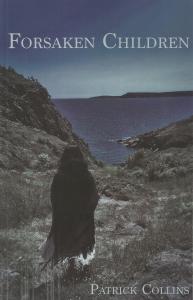 Two stories of woe are being played out in different parts of the world.
Two stories of woe are being played out in different parts of the world.
First, in the community of Highlands, in Bay St. George on Newfoundland’s west coast, Catherine MacInnis has suffered a heartbreaking tragedy that brings her to the brink of despair. Indeed, her family wonders if she ever can or will escape.
At the same time, Scottish boys from Greenock are stowaways on a ship, the Arran. They are consumed with their own tales of suffering.
The lives of the woman and the boys are destined to connect in ways none of them can imagine.
This is the context for the story Patrick J. Collins, a native of Riverhead, Harbour Grace, explores in his latest book, Forsaken Children. It is a work of fiction, based on real life facts.
“I am a writer who needs to be motivated,” he admits. “In fact, my writing has to be driven, provoked by another story or event.”
Such stories cause him to “drill further down in order to understand the underlying motif. I am often incensed, maybe even disturbed, by what happens to real people, yet they survive.”
The almost unbelievable story Collins captures in his book has inspired the literary imagination of writers both far and near.
In 1937, George Blake included a chapter on the incident in his book, Down to the Sea: The Romance of the Clyde, its Ships and Shipbuilders.
In 1964, A. J. Stevenson wrote about “A Newfoundland Tragedy” in The Atlantic Advocate.
A year later, Edward Rowe Snow devoted a chapter to “The St. George’s Bay Horror” in his book, Astounding Tales of the Sea.
A decade later, local columnist Don Morris discussed “an episode of brutality at sea” for the readers of The Atlantic Advocate. In 1987, Morris retold the story of “a ship of pain and torment for young stowaways” in The Sunday Express.
And, in 1999, Isabel Anderson published an article, “Six Stowaways Cast Adrift On Ice” in Scottish Memories.
Patrick Collins’ approach to writing is to “generally read a great deal of history and almost always find something which turns my head. I learn as much as I can about the true story in old newspapers etc. and then imagine a tangential plot which would enhance the original story.”
Thus, he explains, “Catherine MacInnis from Highlands, Newfoundland, was the woman who spotted the survivors from Scotland, and successfully got the local fishermen to bring them to safety.
“Except for her role in saving the boys, the story of her life at Highlands is totally fictional.”
A functional fusion of fact and fiction.
Undoubtedly, Collins realizes that his book is not the final word on the horrific event that unfolded in St. George’s Bay in 1868.
John Brand, an Australian and great-grandson of one of the stowaways on the Arran, has been writing a book for several years. He has visited Newfoundland and gone to St. George’s Bay to see where his great-grandfather came ashore.
“I found Newfoundland to be a very pretty place,” Brand emailed me, “although no doubt extremely harsh in winter. A little different to the tropical climate I live in.”
Since 2006, I have been researching the St. George’s Bay Horror. I have in my possession copies of British shipping newspapers of the day, along with the crew agreements for the voyage of the Arran.
Collins is blessed to be a member of the Saltwater Writing Circle, from whom he receives “unceasing inspiration.”
The Circle is, he explains, “a group of writers who often get together, particularly in the winter months. We share our own stories which we have written for that evening and use the stories to grow our fellowship. Much discussion and friendship has evolved as a result.”
At the rate at which Collins writes books–Forsaken Children is his sixth since 2010–his fans can expect another one in the not-too-distant future. He is a veritable writing machine, whose fast-paced works of historical fiction justifiably line bookstore shelves.
Forsaken Children is published by DRC Publishing.